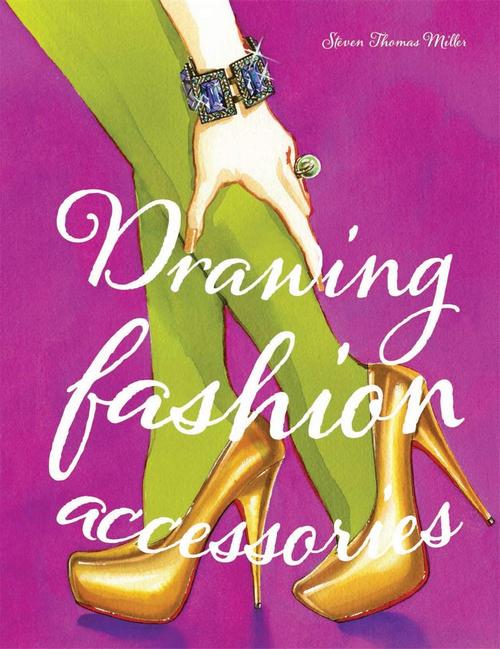
CONTENTS
INTRODUCTION 6
CHAPTER 1
USING DIFFERENT MEDIA AND TOOLS 8
Basics of dry media 10
Basics of wet media 14
Papers 20
Tools 22
Software 23
CHAPTER 2
FOOTWEAR 25
Introduction to drawing footwear 26
The three-quarter view 28
The side and top view 29
Drawing the three-quarter view 30
Drawing the side view 32
Drawing the top view 33
Drawing high boots 35
Drawing work or hiking boots 36
Drawing sandals 37
Drawing platforms 38
Drawing athletic footwear 40
Drawing espadrilles 41
Drawing various views 42
Rendering buffed leather 44
Rendering satin 45
Rendering patent leather 46
Rendering suede 47
Rendering woven fabrics 48
Rendering canvas or tweed 49
Rendering fur 50
Rendering beading 51
Rendering sequins 52
Rendering lace 53
Rendering alligator 54
Rendering snakeskin 56
Rendering acrylic 57
Rendering metallic leather 58
Drawing children’s shoes 59
Flat drawings for production 60
Glossary of shoe terminology 62
Glossary of construction
terminology 63
Glossary of toe shapes 64
Glossary of heel shapes 66
Glossary of shoe silhouettes 68
Glossary of boot silhouettes 70
CHAPTER 3
MILLINERY 72
Introduction to drawing the hat on
the head 74
Templates for different views of the head 77
Templates for men’s hats 80
Rendering fabric textures 82
Drawing blocked and sewn hats 84
Rendering feathers 86
Rendering bows 87
Rendering ribbons 88
Rendering novelties, fruit, and fl owers 89
Rendering netting 91
Glossary of hat terminology 92
Glossary of hat silhouettes 93
CHAPTER 4
BAGS, PURSES, AND BELTS 98
Introduction to drawing handbags 100
Drawing an evening bag 102
Drawing a straw bag 104
Drawing a quilted bag 105
Drawing a monogrammed bag 106
Drawing rhinestone and beaded bags 107
Drawing a hard-shell bag 108
Drawing a metallic bag 109
Rendering tooled and embossed fi nishes 110
Drawing wallets and covers 112
Rendering cloth bags 113
Rendering other textures 114
Drawing chain mail 116
Drawing belts and buckles 117
Glossary of bag silhouettes 118
CHAPTER 5
THE BEAUTY HEAD AND COSMETICS 121
Introduction to face shapes 122
Drawing the beauty head 124
Drawing eyes 126
Drawing mouths 131
Drawing noses 134
Drawing ears 135
Drawing hair 136
Drawing profi les 138
Drawing three-quarter heads 139
Drawing angled heads 141
Drawing perfume bottles 142
Drawing frosted glass and crystal bottles 143
Drawing cosmetics and cosmetic
accessories 145
CHAPTER 6
JEWELRY 146
Introduction to cut stone shapes 148
Drawing cut stones 149
Drawing colored gemstones 150
Drawing pearls 151
Drawing pavé 152
Drawing rings 153
Drawing fl at gold and silver necklaces 154
Drawing gold chain necklaces 155
Drawing earrings 156
Drawing sunglasses 157
Drawing watches 158
Rendering crystal and wood 159
Glossary of jewelry terminology 161
CHAPTER 7
FASHION FIGURE DRAWING 163
Introduction to basic proportion 164
Gesturing the female fi gure 166
Gesturing the male fi gure 167
Drawing shape 168
Drawing the silhouette 170
Drawing shadow 172
Drawing shadow on drapery 173
Drawing shadow on the fi gure 173
Drawing gesture, mass, and form 174
Drawing hands 176
Drawing feet 178
Drawing partial fi gures 180
Glossary of womenswear 182
Glossary of menswear 184
Glossary of rendering fabric 186
FURTHER READING 189
INDEX 190
PICTURE CREDITS AND
ACKNOWLEDGMENTS 192
INTRODUCTION
Illustrating fashion accessories can open doors into the fashion world you didn’t even know existed, as well as providing an avenue for art and style you never imagined your work might travel. This book will help you learn a variety of studio techniques while also showing you the applications within the fashion marketplace where you can apply them. Some might argue that a designer does not need to know how to draw, but I have never known one who didn’t go further and command more value because they invested time in learning the disciplines of illustrating their craft.
There will always be a need for editorial illustrations in print and fashion exhibitions. This is the type of imagery that grabs your attention and fi res up your imagination about the styles or trends it is projecting, as shown with the alligator handbag in fi gure 1. It is art meant to inspire and attract with the sheer excitement of an idea. Then there is the ever-present need to sell that ready-to-wear accessory, as in fi gure 2, making it look as if it were the only couture piece made for that one special retail client.
Fashion art used for commercial solutions has the ability to tell the truth about an item while still bringing an idealized fantasy to its character, stirring up the desires that make it a shopper’s must-have. Of course, none of this would be possible without a manufacturer bringing the designer’s concept to reality. To accomplish that task with accuracy and specifi c individuality, a blueprint must fi rst be made, as the fl at drawing in fi gure 3 demonstrates.
These three types of illustration each hold their own value in fashion and will always provide a way for a designer or retailer to bring uniqueness and identity to their particular accessory.
It is the artist’s challenge to take a medium, a surface, add imagination and their personal fl avor to the mix, and stir the viewer’s desires to want the fashion they draw. With the media introduced and the step-by-step instructions in this book, our goal is to give you the tools necessary to become the illustrator you are longing to be, or challenge you to reach beyond your current skill level to master your art. This text will walk you through the basics of observing and styling fashion accessories so you can avoid common mistakes and possible rejection of your work. The step-bystep demonstrations will also instruct you in media choice and texture rendering. This book does not aim to teach you a style of art so much as help you develop in the direction of your own choosing and give you the foundational skills necessary to evolve your work alongside developing cultural trends.
